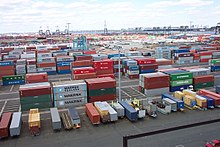
Back Behouering Afrikaans نظام النقل بالحاويات Arabic Kontejnerizace Czech Amlwythiant Welsh Containertransport German Contenedorización Spanish Conteneurisation French Konténerizáció Hungarian Containerizzazione Italian コンテナリゼーション Japanese





Containerization is a system of intermodal freight transport using intermodal containers (also called shipping containers, or ISO containers).[1] Containerization, also referred as container stuffing or container loading, is the process of unitization of cargoes in exports. Containerization is the predominant form of unitization of export cargoes today, as opposed to other systems such as the barge system or palletization.[2] The containers have standardized dimensions. They can be loaded and unloaded, stacked, transported efficiently over long distances, and transferred from one mode of transport to another—container ships, rail transport flatcars, and semi-trailer trucks—without being opened. The handling system is mechanized so that all handling is done with cranes[3] and special forklift trucks. All containers are numbered and tracked using computerized systems.
Containerization originated several centuries ago but was not well developed or widely applied until after World War II, when it dramatically reduced the costs of transport, supported the post-war boom in international trade, and was a major element in globalization. Containerization eliminated manual sorting of most shipments and the need for dock front warehouses, while displacing many thousands of dock workers who formerly simply handled break bulk cargo. Containerization reduced congestion in ports, significantly shortened shipping time, and reduced losses from damage and theft.[4]
Containers can be made from a wide range of materials such as steel, fibre-reinforced polymer, aluminum or a combination. Containers made from weathering steel are used to minimize maintenance needs.
- ^ Edmonds, John (2017-03-03). "The Freight Essentials: Getting Your Products Across The Ocean". Retrieved 2017-09-01.
- ^ Baskar, Mariappa Babu (2021). Blue Book of Container Stuffing – The Container Stuffing Management in International Logistics: The Economics Behind (I ed.). Auckland: Massey Press. ISBN 978-1703213027.
- ^ Lewandowski, Krzysztof (2016). "Growth in the Size of Unit Loads and Shipping Containers from Antique to WWI". Packaging Technology and Science. 29 (8–9): 451–478. doi:10.1002/pts.2231. ISSN 1099-1522. S2CID 113982441.
- ^ Levinson 2006.